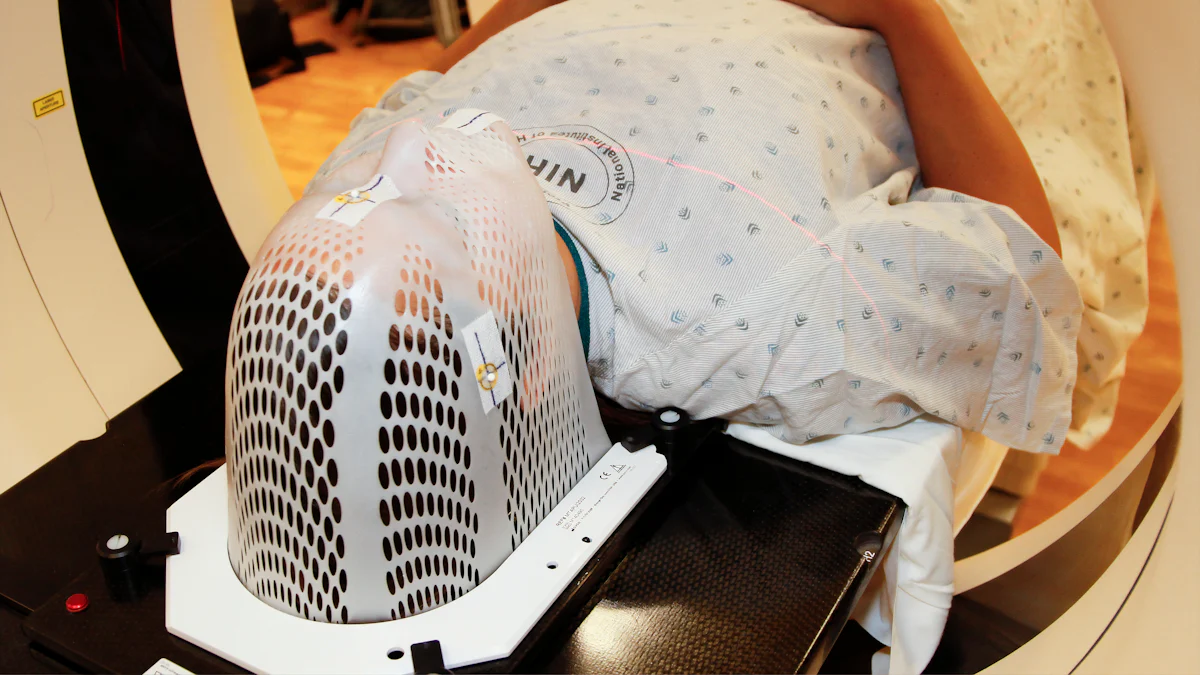Comparing FEP Heat Shrink Tubing with Other Materials for Radiation Therapy

FEP heat shrink tubing for radiation therapy stands out due to its exceptional properties. Its chemical inertness ensures compatibility with most substances, while its resistance to UV radiation enhances durability in demanding environments. FEP offers high thermal stability, making it reliable across a wide temperature range. Unlike other materials, it maintains mechanical integrity under radiation exposure, ensuring long-term performance. The tight fit provided by heat shrink tubing improves device functionality, especially in medical applications. Additionally, heat shrink sleeves made from FEP deliver superior protection, making them indispensable for critical uses in radiation therapy.
Overview of FEP Heat Shrink Tubing for Radiation Therapy

Key Properties of FEP Tubing
Heat resistance and broad thermal range (-200°C to 200°C)
FEP, a type of fluoropolymer heat shrink, exhibits remarkable thermal stability. It can withstand temperatures as low as -200°C and as high as 200°C without compromising its structural integrity. This broad thermal range makes it ideal for demanding environments, including radiation therapy. Unlike many other materials, FEP maintains its mechanical properties even under extreme heat or cold, ensuring consistent performance in critical applications. Its ability to endure such conditions highlights its reliability in medical settings where temperature fluctuations are common.
Chemical inertness and low gas permeability
FEP tubing is chemically inert, meaning it resists reactions with most chemicals and solvents. This property ensures that it remains stable and safe when exposed to aggressive substances often encountered in medical and industrial environments. Additionally, its low gas permeability minimizes the risk of contamination, making it a preferred choice for applications requiring sterility and precision. These characteristics position FEP as a superior material for radiation therapy, where maintaining purity and reliability is essential.
Transparency and optical clarity
The transparency of FEP tubing sets it apart from many other materials. Its optical clarity allows for easy visual inspection of the components it encases, which is particularly valuable in medical applications. This feature ensures that healthcare professionals can monitor devices or fluids without removing the tubing, enhancing efficiency and safety. The clear nature of FEP also makes it suitable for applications requiring visibility, such as microfluidic systems or custom-formed FEP tubes used in specialized medical devices.
Advantages in Medical Applications
Tight fit with a 1.6:1 shrink ratio
FEP heat shrink tubing for radiation therapy offers a precise fit due to its 1.6:1 shrink ratio. This tight fit ensures that the tubing conforms securely to the underlying components, providing enhanced protection and functionality. The snug fit improves the performance of medical devices by reducing movement and ensuring stability. This feature is particularly beneficial in radiation therapy, where precision and reliability are critical.
Compatibility with softer materials due to lower recovery temperature
FEP tubing has a lower recovery temperature compared to other fluoropolymer heat shrink materials. This property allows it to be used with softer materials without causing damage. For instance, it can encase delicate components or softer substrates without compromising their integrity. This compatibility expands its versatility, making it suitable for a wide range of applications in the medical field, including custom-formed FEP tubes designed for specific devices.
Reliability in harsh environments, including radiation exposure
FEP demonstrates exceptional durability in harsh environments. Its resistance to UV radiation and mechanical stress ensures long-term performance, even under challenging conditions. In radiation therapy, where exposure to radiation and other stressors is inevitable, FEP tubing maintains its properties without degradation. This reliability makes it an indispensable material for heat shrink sleeves used in critical medical applications.
Comparison with Other Materials for Radiation Therapy

Silicone Tubing
Flexibility and elasticity compared to FEP
Silicone tubing offers exceptional flexibility and elasticity, making it a preferred choice for applications requiring frequent bending or movement. Its stretchable nature allows it to adapt to dynamic environments, which can be advantageous in certain medical devices. However, when compared to FEP, silicone lacks the rigidity and structural stability that are often necessary for precise applications like radiation therapy. While silicone excels in flexibility, it may not provide the same level of mechanical reliability under prolonged stress.
Higher temperature tolerance but lower chemical resistance
Silicone tubing withstands higher temperatures than FEP, withstanding up to 250°C in some cases. This makes it suitable for high-temperature sterilization processes. However, its chemical resistance falls short when exposed to aggressive solvents or harsh chemicals. In contrast, FEP heat shrink tubing for radiation therapy resists chemical degradation, ensuring long-term performance in environments where chemical exposure is common. This difference highlights the importance of material selection based on specific environmental demands.
Biocompatibility and suitability for medical-grade applications
Silicone tubing is widely recognized for its biocompatibility, making it a trusted material for medical-grade applications. It is often used in implants, catheters, and other devices that come into direct contact with the human body. While FEP also demonstrates biocompatibility, its additional properties, such as chemical inertness and low gas permeability, make it more versatile for applications requiring sterility and precision. Both materials serve critical roles in healthcare, but their suitability depends on the specific requirements of the application.
Polyolefin Tubing
Cost-effectiveness and ease of application
Polyolefin tubing stands out for its affordability and ease of use. It is a cost-effective solution for general-purpose applications, including basic insulation and protection. Its straightforward installation process makes it accessible for various industries. However, FEP offers superior performance in demanding environments, justifying its higher cost for critical applications like radiation therapy. The trade-off between cost and performance often determines the choice between these materials.
Higher shrink ratio but lower radiation resistance
Polyolefin tubing typically features a higher shrink ratio, allowing it to conform to irregular shapes more effectively. Despite this advantage, it lacks the radiation resistance of FEP heat shrink tubing for radiation therapy. Prolonged exposure to radiation can degrade polyolefin, compromising its mechanical integrity. In contrast, FEP maintains its properties under radiation, ensuring reliability in medical devices used in therapy settings. This distinction underscores the importance of radiation resistance in material selection.
Limited durability in harsh environments
Polyolefin tubing performs well in standard conditions but struggles in harsh environments. It is prone to wear and tear when exposed to UV radiation, extreme temperatures, or aggressive chemicals. FEP, on the other hand, excels in such conditions due to its chemical inertness, UV stability, and broad thermal range. For applications requiring durability and long-term performance, FEP proves to be a more reliable choice.
PVC Tubing
Durability and mechanical strength
PVC tubing offers notable durability and mechanical strength, making it suitable for applications requiring robust protection. Its rigid structure provides stability, but it lacks the flexibility of FEP. While PVC performs well in many industrial settings, its mechanical properties may not meet the stringent demands of radiation therapy. FEP heat shrink sleeves provide a better balance of strength and adaptability, ensuring optimal performance in medical environments.
Chemical resistance and safety concerns (e.g., potential toxicity)
PVC demonstrates moderate chemical resistance, but concerns about potential toxicity limit its use in sensitive applications. Additives like plasticizers can leach out over time, posing risks in medical settings. FEP, being chemically inert, eliminates such concerns, making it a safer alternative for critical applications. Its non-reactive nature ensures compatibility with medical devices and components, enhancing safety and reliability.
Environmental considerations and limited performance under radiation
PVC raises environmental concerns due to its production and disposal processes, which can release harmful substances. Additionally, its performance under radiation is limited, as prolonged exposure can lead to degradation. FEP, with its superior radiation resistance and environmentally stable properties, offers a more sustainable and reliable solution for radiation therapy. Its ability to maintain integrity under harsh conditions makes it a preferred choice for long-term applications.
Suitability of FEP Heat Shrink Tubing for Radiation Therapy
Performance Under Radiation Exposure
Resistance to degradation, discoloration, and mechanical failure
FEP heat shrink tubing for radiation therapy demonstrates remarkable resistance to degradation caused by prolonged radiation exposure. Unlike many other materials, FEP retains its structural integrity and does not discolor or weaken under harsh conditions. This resilience ensures that medical devices encased in FEP tubing maintain their functionality over extended periods. The material's ability to withstand mechanical stress without failure makes it a reliable choice for critical applications in radiation therapy.
Maintenance of properties in clinical environments
FEP maintains its essential properties even in demanding clinical environments. Its chemical inertness prevents reactions with substances commonly encountered in medical settings, ensuring consistent performance. Additionally, its low moisture absorption and resistance to UV radiation contribute to its durability. These characteristics make FEP an ideal material for medical devices used in radiation therapy, where reliability and stability are paramount.
Safety and Reliability in Medical Applications
Non-reactivity with medical devices and components
FEP exhibits exceptional non-reactivity, making it compatible with a wide range of medical devices and components. Its chemical inertness ensures that it does not interfere with the functionality of sensitive equipment. This property is particularly valuable in radiation therapy, where precision and safety are critical. By preventing unwanted chemical interactions, FEP enhances the overall reliability of medical devices.
Long-term durability in radiation therapy settings
FEP offers long-term durability, even in the challenging conditions of radiation therapy. Its resistance to extreme temperatures, UV radiation, and chemical exposure ensures that it remains effective over time. This durability reduces the need for frequent replacements, making it a cost-effective solution for healthcare providers. Heat shrink sleeves made from FEP provide consistent protection, ensuring the longevity of medical devices in radiation therapy applications.
Scenarios Where FEP Tubing Excels
Applications requiring chemical resistance and UV stability
FEP excels in applications that demand high chemical resistance and UV stability. Its ability to resist aggressive chemicals and prolonged UV exposure makes it suitable for environments where other materials may fail. For instance, FEP is often used in medical devices that require sterility and exposure to light-sensitive processes. Its superior performance in such scenarios highlights its versatility and reliability.
Use in devices exposed to broad temperature ranges
FEP performs exceptionally well in devices exposed to a wide range of temperatures. Its thermal stability allows it to function effectively in conditions ranging from -200°C to 200°C. This broad temperature tolerance makes it ideal for medical applications where devices must endure extreme heat or cold. Whether used in laboratory equipment or radiation therapy devices, FEP ensures consistent performance across varying conditions.
FEP heat shrink tubing for radiation therapy offers unmatched performance due to its chemical resistance, UV stability, and mechanical reliability. Its ability to endure extreme temperatures and resist harsh chemicals makes it a superior choice for demanding medical applications. While silicone, polyolefin, and PVC tubing have their merits, FEP stands out for its durability and adaptability in harsh environments. Heat shrink sleeves made from FEP ensure long-term protection and precision. Medical professionals and engineers should prioritize FEP for critical radiation therapy applications where safety and reliability are essential.
FAQ
What is FEP tubing made of?
FEP tubing consists of fluorinated ethylene-propylene, a copolymer of tetrafluoroethylene (TFE). This material provides excellent chemical resistance and thermal stability. Manufacturers often produce FEP tubing in transparent forms, but it can also come in various colors to simplify identification in complex systems.
What are the primary applications of FEP tubing?
FEP tubing serves a wide range of industries due to its versatility. It is commonly used in biopharmaceutical and laboratory settings where chemical resistance and exposure to extreme temperatures are essential. Additionally, it performs well in low-pressure applications, making it a cost-effective solution for many specialized uses.
How does FEP tubing differ from PTFE tubing?
FEP tubing is the melt-processable version of PTFE tubing. While both materials share similar properties, FEP has a lower maximum operating temperature of +200°C. One significant advantage of FEP tubing is its ease of cutting and forming, which simplifies its use in custom applications.
Why is FEP tubing suitable for radiation therapy?
FEP tubing excels in radiation therapy due to its resistance to UV radiation, chemical inertness, and ability to maintain mechanical integrity under radiation exposure. These properties ensure that it performs reliably in demanding medical environments, making it a preferred choice for critical applications.
Can FEP tubing handle extreme temperatures?
Yes, FEP tubing can withstand a broad temperature range from -200°C to +200°C. This capability makes it ideal for applications requiring thermal stability, such as radiation therapy and laboratory processes. Its performance remains consistent even under extreme heat or cold.
Is FEP tubing safe for medical applications?
FEP tubing is highly safe for medical use. Its chemical inertness prevents reactions with sensitive medical devices and components. Additionally, its low gas permeability ensures sterility, making it a reliable choice for healthcare environments where safety is paramount.
How does FEP tubing compare to silicone tubing?
FEP tubing offers superior chemical resistance and durability under radiation exposure compared to silicone tubing. While silicone provides greater flexibility and elasticity, FEP's structural stability and resistance to harsh environments make it more suitable for applications like radiation therapy.
What makes FEP tubing environmentally friendly?
FEP tubing is considered environmentally stable due to its durability and resistance to degradation. Unlike materials such as PVC, it does not release harmful substances during use or disposal. This property makes it a more sustainable option for long-term applications.
Can FEP tubing be used with softer materials?
Yes, FEP tubing's lower recovery temperature allows it to be used with softer materials without causing damage. This feature enhances its versatility, enabling it to encase delicate components in medical and industrial applications effectively.
Why is transparency important in FEP tubing?
The transparency of FEP tubing allows for easy visual inspection of the components it encases. This feature is particularly valuable in medical and laboratory settings, where monitoring devices or fluids without removing the tubing enhances efficiency and safety.
See Also
The Importance of Ultra-Thin PET Tubing in Healthcare
New Developments in PTFE Liners for Medical Applications
A Comparison of Global Manufacturers for Etched PTFE Liners

